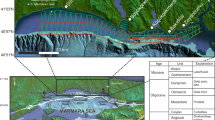Abstract
Seventy-seven surface sediment samples and core samples from the outer Sunda Shelf were analyzed and a number of seismic profiles of the shelf were interpreted. The bottom sediments could be divided into six types: terrigenous sand, biogenic sand, silt-sand, clay-silt-sand, clayey silt and coral reef detritus. Our seismic data showed a thick, prograding Pleistocene deltaic sequence near the shelf-break and a thin Holocene sedimentary layer on the outer shelf. Eleven thermoluminescence (TL) ages were determined. The oldest relict sediments were derived from Late Pleistocene deposits. Based on sediment types, ages, and origins, five sedimentary areas were identified: area of modern Mekong sediments; insular shelf area receiving modern sediments from small Borneo rivers; shelf area near the Natuna-Anambas islands in the southeastern Gulf of Thailand Basin off the Malay Peninsula; area of relict sediments on the outer shelf north of the Natuna Islands, and typical coral reefs and detritus sediments.
Similar content being viewed by others
References
Ben-Avraham, Z., Emery, K. O., 1973. Structural framework of the Sunda Shelf.Amer. Assoc. Petroleum Geol. Bull. 57(12): 2323–2366.
Biswas B., 1973. Quaternary changes in the South China Sea.Geol. Soc. Malaysia Bull. 6: 229–256.
Chen, S., Wu, B., Wang, X. et al., 1993. Sedimentary geochemistry.In: Luo, Y.et al., (eds.) Quaternary Sedimentary Geology of the Nansha Islands and the Adjacent Sea Areas, Hubei Science and Technology Publication House, Wuhan, p. 107–133. (in Chinese)
Dickerson, R. E., 1941. Molengraaff River: a drowned Pleistocene stream.In: Shifting of Sea Floors and Coastlines.Univ. Penn. Bicentennial Conf., 1940, p. 13–30.
Emery, E. O., Niino, H., 1963. Sediments of the Gulf of Thailand and adjacent continental shelf.Geol. Soc. Amer. Bull. 74: 541–554.
Evans, C. D. R., Brett, C. P., James, J. W. C. et al., 1995. Shallow Seismic Reflection Profiles from the Waters of East and Southeast Asia: An Interpretation Manual and Atlas. British Geological Survey, p. 66–67.
Guo, L., Nie, B., Zhu, Y. et al., 1994. Modern coral reefs in the South China Sea.In: Zhou, D., Liang, Y., and Zeng, C. K. (eds.), Oceanology of China Sea, Kluwer Academic Publ., Vol. 2 p. 477–486.
Haile, N. S., 1972. The geomorphology and geology of the northern part of the Sunda Shelf and its place in the Sunda Mountain System.Pacific Geology 6: 73–89.
La Fond, E. C., 1966. South China Sea.In: The Encyclopedia of Oceanography, Reinhold Publ. Corp. New York, p. 829–836.
Lees, B. G., Lu, Y., Pric, D. M., 1992. Thermoluminescence dating of dunes at Cape St. Lambert, East Kimberleys, northwestern Australia.Marine Geology 106: 131–139.
Luo, Y., Feng, W., Lin, H., 1993. Grain size and bottom sediment types.In: Luo, Y. et al., (eds.) Quaternary Sedimentary Geology of the Nansha Islands and the Adjacent Sea Areas. Hubei Science and Technology, Publication House, Wuhan, p. 13–19. (in Chinese)
Su G., Wang, T., 1994. Basic characteristics of modern sedimentation in the South China Sea.In: Zhou, D., Liang, Y. and Zeng, C. (eds), Oceanology of China Sea, Kluwer Academic Publishers, Vol. 2 p. 407–418.
Tjia, H. D., Fujii, S., Kigoshi, K., 1977. Changes of sea leval in the southern South China Sea during Quaternary times.In: Quaternary Geology of the Malay-Indonesian Coastal and Offshore Areas. United Nations ESCAPCCOP Technical Publication, No. 5, p. 11–36.
Tjia, H. D., 1980. The Sunda Shelf, Southeast Asia. Zeitschrift für Geomorphologie, N. F.,24(4): 405–427.
Wu, S. G., Luo, Y. L., 1994. Relict sediments on the southern shelf of the South China Sea.Tropical Ocean.13(3): 47–53. (in Chinese with English abstract)
Xia, K. Y., Huang, C. L., 1994. Geological structure and geophysical characteristics of Nansha block in the southern South China Sea.In: Zhou D., Liang, Y. B. and Zeng C. K. (eds.), Oceanology of China Sea, Kluwer Academic Publishers, Vol. 2 p. 373–384.
Zhu, Y., Guo, L., Nie, B. et al., 1990. Vertical distribution zones of recent biocarbonate sediments in the South China Sea.Tropical Ocean. 9(1): 43–51. (in Chinese with English abstract)
Author information
Authors and Affiliations
Rights and permissions
About this article
Cite this article
Shi-guo, W., Wong, H.K., You-lang, L. et al. Distribution and origin of sediments on the northern Sunda Shelf, South China Sea. Chin. J. Ocean. Limnol. 17, 28–40 (1999). https://doi.org/10.1007/BF02842697
Received:
Accepted:
Issue Date:
DOI: https://doi.org/10.1007/BF02842697




